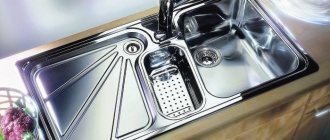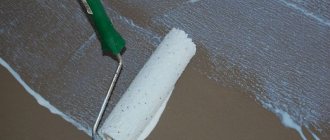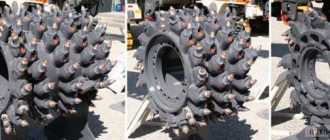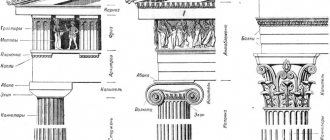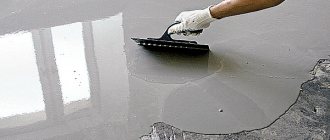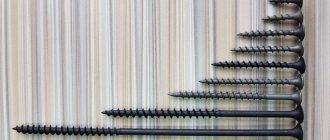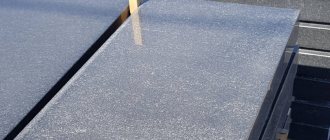The need to use snow guards
In the domestic space, snow guards have become known relatively recently, despite the fact that in most European countries they are used almost everywhere. This is partly due to not very successful marketing moves that form the wrong opinion about these products - most potential buyers still consider snow guards to be a useless purchase.
However, most ordinary people change their opinion after approximate calculations of the amount of snow on the roof. In light frosts, a meter-long snow crust exerts a pressure on the roof equal to 60 kilograms per 1 square meter. If the snow is wet, then this value can increase to 200 kilograms per square meter. The indicators are very significant, especially considering the likelihood that this entire mass could collapse on something or someone at any moment.
Another argument used by opponents of snow retainers is that the roof becomes unsightly and visually seems too loaded. This statement is also very far from the truth: even the simplest modern devices for snow retention have good decorative properties, not to mention elements that are specially designed to be built into a specific building exterior.
In addition, you need to understand that installing snow guards is not a mandatory task. In all existing building codes there is not a single clause regarding the fact that these elements must be installed regardless of any conditions. There are only recommendations that say in what situations it is advisable to use snow guards.
If we put all of the above together, we can conclude the following: installing snow barriers on the roof will not be superfluous, so if possible, it is worth doing this work. Of course, the functioning of snow guards remains invisible most of the time, but in certain situations they can save not only property, but also someone’s life.
Types and characteristics of snow guards
Sometimes there are roofing kits on sale that also include snow guards. Of course, purchasing such a set can be called the simplest solution, but there are no guarantees that the roof will ultimately look good and cope with snow loads properly.
To achieve maximum efficiency and good decorative properties of snow guards, you need to choose them yourself, having first carefully studied the characteristics of all types of these devices.
Depending on the principle of operation, the following types of snow retainers are distinguished:
- Snow barriers . Such devices are necessary to completely prevent the passage of snow. It is advisable to use snow barriers, taking into account the principle of their operation, only if the amount of snow that needs to be retained is small.
- Snow cutters . Devices of this type work in accordance with their name - snow cutters crush the snow mass, ensuring its gradual removal from the roof in small portions.
The presented types of snow retainers have several varieties that are worth considering in more detail.
Types of snow retention devices
Snow catching structures can be:
- tubular;
- lattice;
- corner;
- in the form of hooks (snow stops);
- lamellar.
Some of the devices are universal, others can be installed on certain types of roofing depending on the snowy area. It is impossible to install snow retention on the roof without the presence of safety devices.
Roofing ladders are installed on top of the covering material - they allow you to safely monitor the condition of the roof, and when the height of the building is more than 6 meters, it is necessary to create a protective fence made of reinforcement.
The simplest design - logs on hooks
Snow guards made from ordinary logs suspended from the roof on hooks are a fairly old idea that have been used for many centuries in the Alps, especially on tiled roofs. Of course, in its original form, such protection of the chimney from snow melting is irrelevant - under a log hanging on the roof, during a thaw, ice will most likely appear, which in the near future will cause the log itself to fall off the roof surface.
To get rid of this drawback, modern analogues of a similar design have been developed, which make it possible to keep snow on the roof. More modern protection from snow on the roof is distinguished by high-quality hooks and the presence of special metal devices that ensure retention of snow masses.
Snow guard: what is it and what is it for?
A snow retainer is a special structure that is mounted on the roof of a building and holds snow on its surface. Snow barrier elements perform three main functions:
- Prevent sudden meltdown of snow mass.
- Improves roof sound insulation.
- Strengthen the thermal insulation effect.
Snow stops delay the avalanche-like sliding of snow mass from the roof during a snowy winter and warming. This reduces the risk of accidents and protects the drain and objects near the house (trees, cars, small buildings).
Installing snow barriers allows you to maintain a thick layer of snow on the roof throughout the winter. This natural covering provides additional protection against external noise. In addition, heat is better retained on the upper floors of the house. This means that the rooms maintain a comfortable temperature with lower financial costs for heating.
Corner type snow barriers - simple protection from snow
The next type of snow retainer that will be discussed is corner (plate) snow barriers. Structurally, such protection against snow falling off the roof consists of ordinary metal sheets, which are bent in such a way as to form a threshold that retains snow on the roof surface.
Corner snow retainers belong to the category of the least reliable devices, which is largely due to the small thickness of the metal used and the accompanying low strength of the products. Of course, manufacturers are well aware of this problem and reinforce the corner with an additional element that increases the rigidity of the structure, but in practice this is often not enough.
This type of device works on the principle of a snow barrier, that is, it keeps snow on the roof. Considering the low strength of corner snow retainers, it is advisable to install them only on those roofs that themselves have at least a small ability to retain snow.
For proper efficiency, corner snow retainers are used in combination with yokes - small stoppers that are attached to roof slopes that have a large slope. The yokes have a small height and hold the snow masses in their lowest part, thereby protecting the corner snow barriers from the melting of large amounts of snow.
Of course, corner-type snow retainers also have positive qualities. Due to the triangular cross-sectional shape, such devices have good rigidity under transverse and longitudinal loads. In addition, for piece tiles, ceramic and sand roofs, corner snow retainers are the most reliable device possible.
To distribute loads evenly, corner fixtures are installed in rows staggered. For such a scheme to be quite effective, you need to know at what distance the snow guards are installed. The installation step of the protective elements should be equal to the distance between the tiles, doubled.
How to choose snow retention devices
You should think about the need to install such a modern structure as a snow guard already at the stage of building a house
What are the main factors that are important to consider:
- The fundamental point is the type of roof. Depending on the selected material for the roof, the option of the snow retention system is determined. If the house has a metal roof, for example, made of corrugated sheets or metal tiles, then additional elements to it should be made of the same material. A tubular system would be an excellent choice in this situation.
- An important parameter for selection will be the amount of precipitation falling in the region of residence over the entire winter.
- Despite the fact that most owners of private houses try to choose a standard roof design, the slope angle for each building may be different, and this must also be taken into account when choosing.
For greater reliability, different types of snow holders can be combined
When purchasing snow guards, experts recommend following three key points:
- Possibility of hermetically sealed fastening to the roof base.
- Match the maximum load level provided for the snow guard to the height of the snow cover in your region.
- Strength of parts and connections of the structure.
Each of the systems that allows you to protect people from large amounts of snow falling off the roof has its own characteristics, but there are several aspects that are characteristic of the installation of any of them. Before you begin, you must:
In the places where snow impellers are planned to be placed, create an additional reinforcing frame for the sheathing. The very first row of the structure should be fastened no closer than 50 cm from the roof eaves. Pay attention to the correct location of the products - strictly parallel to the edge of the roof.
Choose the correct arrangement of snow retention devices: in a checkerboard pattern (hook, plate) or in one line (lattice, tubular). Calculate the required number of snow guards: on large roofs it is advisable to install the system in several rows with a pitch of 40–50 cm for greater protection against the sliding of snow mass.
On roofs with a slope of more than 60 degrees, snow practically does not stay, so installing snow guards will be ineffective.
When choosing snow guards, you need to take into account the snow load. However, this is difficult to do, since it is impossible to determine in advance how much snow will fall in a given year. However, there is still a formula that allows you to do this approximately: Q = G*s, where G is the weight of snow per 1 m2 of roof (this value can be found in a special table), s is a coefficient that depends on the slope of the roof (1 - slope less than 25 degrees, 0.7 - slope from 25 to 60 degrees).
Table: specific gravity of snow for different areas
| Regions of the Russian Federation | 1 | 2 | 3 | 4 | 5 | 6 | 7 | 8 |
| Q, kg/m2 | 80 | 120 | 180 | 240 | 320 | 400 | 480 | 560 |
The numbering of regions is carried out according to the map of snow regions of the Russian Federation.
Areas with a certain level of snow cover per square meter of area are highlighted on the map in different colors.
Thus, with proper calculation, snow retainers can be successfully used to prevent snow ice caps from falling off the roofs of buildings. You can choose the most suitable one from the existing varieties of systems, having an idea about the roofing used, the climatic conditions of the region of residence, the size of the roof slope and its angle of inclination. Each individual model has its own rules for installation.
When deciding whether to install snow guards, you need to remember that in addition to the undoubted advantages, such designs also have disadvantages depending on the type:
- plate snow retainers are not strong enough and are easily deformed if they are exposed to a large amount of snow, which they are not always able to hold;
- snow stops or point snow retainers can only be used on soft roofs with a slight slope, and it is also recommended to supplement them with other structures;
- Tubular snow throws have open fasteners, which is why the tightness of the roofing may be compromised.
Despite the high practicality of snow-resistant products, it is necessary to promptly clear the snow and care for the roof surface in order to avoid shortening its service life. Remember that the constant load from a large volume of snow masses contributes to subsidence of the roofing covering, rafter system and the entire roof frame.
Lattice snow guards
Lattice devices for retaining snow, also called decorative, are installed exclusively along the edge of the roof using brackets.
The list of advantages of these devices looks impressive:
- Versatility, allowing the use of lattice snow guards on any roof;
- Safety for roofing and drainage systems;
- When using this type of snow retainer, snow easily falls off the roof and is divided into small parts, which simplifies the process of melting.
Most often, lattice snow guards are installed on a roof made of natural tiles and are more of a decorative character. Of course, such a design will be able to hold broken pieces of tile on the roof surface, but it is unlikely to withstand large amounts of snow. In addition, if the snow retainer falls off, it will most likely pull the cornice with the drain along with it.
To improve fastening and reduce the load on the supporting elements, they need to be attached directly to the rafter frame, and not to the covering itself. To make the structure as strong and reliable as possible, it is advisable to reinforce the attachment points with additional boards - that is, all roof elements, including snow retainers, need to be thought out in advance.
In general, lattice devices have both pros and cons, so you need to choose the right elements wisely. What these snow guards cannot be denied is their decorative properties, which allow the implementation of the most non-standard design ideas. If the region where the building is located is not characterized by a high level of snow precipitation, then lattice snow barriers should be paid attention first.
Installing snow guards on the roof
Installation of lattice, tubular or plate devices can be carried out both on a new roof and for the purpose of equipping an old roof that does not have defects or damage
It is worth first identifying the places where the presence of snow stoppers is especially important. These include areas of the roof above exits from the building, above attic windows and walkways, as well as areas overlooking objects close to the building.
To achieve maximum protection against sudden snow melting, it is worth placing the elements along the entire length of the roof slope.
For maximum protection against snow melting, snow guards should be located along the entire length of the slope
For installation, self-tapping screws with an anti-corrosion coating are required, which ensure the integrity of the material under the influence of moisture and temperature changes. The snow catcher kit includes installation instructions, fastening elements and the snow stopper system itself. For the job you will also need a screwdriver, a building level and a tape measure.
Installation of snow guards on a corrugated roof
Covering the roof with profiled sheets is a common option. It is easy to mount various types of snow stoppers on such a surface. When installing in one line, you need to retreat about 60 cm from the edge of the eaves overhang. To ensure evenness, you should tighten the lace at this level. Thus, the first row will be positioned correctly, and the installation of the next rows, if necessary, depends on this.
The work package is simple:
- Carrying out markings, that is, determining the location of the first and subsequent levels of snow retention.
- Fixing the brackets with self-tapping screws using rubber pads.
- Screwing is carried out along every second wave (its lower part) to the sheathing.
The fastening scheme for lattice or tubular snow retainers is as simple as possible and involves fixing self-tapping screws to the sheathing through corrugated sheeting.
It is important that the attachment points of the snow guard fall on the sheathing elements
Before fixing, the tubular elements must be joined into a structure of the required length. Staggered installation is also effective and requires equal distances between snow stoppers.
Video: installation of snow guards on a corrugated roof
Installation of snow guards on metal roofing
Metal tiles are also a common roofing option. It is easy to install snow catchers on such a base, and plate, tubular or lattice models are suitable for the job. Fixation of devices is carried out through the roofing material. If the sheathing is weak, then it needs to be strengthened by dismantling part of the roof and installing additional bars along the line where the snow guards are located.
Installation involves the following steps:
- Determining the location of the line on which the device system will run.
- Assembling a set of snow guards without tightening the bolts.
- Reinforcing the sheathing and attaching metal tiles to it.
- Fastening the assembled snow retainer structure. Produced with 8x60 mm bolts using rubber pads.
- The average step between the brackets is 50 cm.
If the roof slope is more than 5.5 m long, then it is best to install snow guards in two rows.
If the snow catchers are matched to the roof covering, they will become part of the overall roof design
When choosing snow catcher brackets, you need to consider the type of metal tile. Some system options have a special protrusion in the supporting part, which eliminates the need to reinforce the sheathing.
Network snow guards
Network-type snow guards are essentially a type of lattice device, but have some design differences. In this case, the protection of the roof from snow is carried out not by vertical lattice elements, but by a mesh, which is attached to a metal frame. The height of this type of snow guard reaches 15 cm, and the length varies between 12-25 cm.
Most often, network devices are installed on multi-story buildings - it is more difficult to remove snow from them, and its mass is an order of magnitude higher than what can accumulate on the roof of a private house. Such snow guards can be installed either one at a time or in structures of several pieces (in the second case, they are connected using detachable grooves).
Toothed protection against snow falling off the roof
Another type of device that allows you to solve the problem with masses of snow on the roof is geared snow splitters on the roof, or “teeth”. Such roof snow blowers have the following operating principle and design: visually, the design is a curved bar with a hook or tooth at the end.
The list of advantages of such snow cutters looks modest, but it includes all the necessary qualities, including:
- Simplicity of design;
- Reliability;
- Good decorative properties.
As a rule, gear-type snow retainers for soft roofs are mounted on roofs that hold snow well on their own - for example, roofs covered with soft tiles. To ensure that the protection of the roof from snow is as effective as possible, “teeth” are installed together with lattice devices.
Types of snow retention systems
Regardless of who installed snow barriers on the roof of a private house, responsibility for the proper condition of the adjacent territory rests, according to the law, with its owners. If the snow mass falling from the roof causes damage to passers-by or other people's property, it is the owner of the home who must compensate for the losses.
Taking into account the above information, a reasonable decision for owners would be to invest money in installing snow retention on the roof, which will provide them with peace of mind and safety for strangers.
Depending on the design of the snow fence, there are the following types:
- Lattice barriers . They are brackets with lattice sections located between them. They are rigidly fixed to the roof. These products are made in the form of rectangular frames made from corners or pipes, which are reinforced with welded cross members. If it is necessary to lengthen the snow stopper, simply join several sections.
- Tubular snow guards . If they are installed, the brackets are attached to the rafters or roof sheathing. Using them, metal pipes are placed in one or two rows. Their design is similar to standard window cornices for curtains and curtains. The amount of snow that such a device can hold depends on the gap between the two pipes, as well as on the distance between the down pipe and the roof. In a region where there is heavy rainfall in winter, the structure should be strengthened in advance by reducing the pipe fixation step. To ensure a uniform load on the roof, tubular structures must be installed relative to the line of load-bearing walls.
- Snow stoppers-hooks . Their shape resembles hooks. These products will not be able to hold a large mass of snow, so they are installed on roofs that are regularly cleaned. Typically, hooks are mounted on soft roofs, made, for example, of bitumen shingles.
- Plate or corner products . They are usually chosen when solving the problem of how to retain snow on a corrugated roof. Such structures are installed on roofs made of metal coverings - galvanized steel sheets, European tiles, etc. Their disadvantage lies in their inability to reliably retain a large mass of snow in the event that it melts unexpectedly.
Tubular snow guards
To prevent snow from falling off the roofs of houses, you can use tubular snow retainers. These devices are quite versatile and are suitable for installation in the most difficult situations where other types of snow guards simply cannot cope.
Tubular devices ensure gradual melting of snow in small portions, which reduces the degree of its danger to a minimum. The dimensions of roof snow retainers look like this: the working elements can be hollow tubes with a diameter of 11 mm or all-metal pipes with a diameter of 10-15 mm.
Types of snow guards for the roof
Snow retainers (or snow catchers) for roofs differ in shape, size, material, and reliability of the design. When choosing the type of snow retainer, it is necessary to take into account how much snow it will have to hold back, and this, in turn, depends on the type of roof, its area and its angle of inclination.
How the snow catcher works also depends on the type of roof, because each type of these devices has a different mechanism for collecting snow masses.
There are the following types of snow guards:
- tubular;
- lattice;
- corner or plate;
- hooks or yokes.
Let's look at each type separately and find out in what cases certain snow retainers are used.
Tubular snow guards
To install tubular snow guards, the brackets are attached to the roofing material. Metal pipes with a diameter of 15-30 mm are passed through them in one or two rows. The total height of the structure is approximately 15 cm. The strength of the system is determined by the distance between the lower pipe and the roof. The optimal distance is 2-3 cm from the roof surface to the first pipe and 8-10 cm between the pipes.
By reducing the pipe fastening pitch, the load that the structure can withstand increases. To distribute the load evenly, tubular snow retainers are installed along the line of the load-bearing wall. This design gradually removes snow from the roof, passing it piece by piece between the pipes.
Tubular snow retainers are installed on roofs with a slope of up to 60°, since on roofs with a slope of more than 60° the snow falls off immediately. Tubular snow guards are the most durable design on the market today. They can often be found on gable and hip roofs
Lattice snow guards
This is a vertical grille, rigidly fixed to the roof with brackets. The material used to make this design is rectangular frames made of pipes or corners. The structure can be extended by joining sections along the short side.
It is recommended to install snow guards in several rows to provide reliable protection from snow sliding down. The dimensions of the grating can be different: from 5-7 cm to 15-20 cm. They are installed on long slopes with a significant slope. The roofing material does not matter - all roofing materials produce their own types of fasteners.
Angle or plate snow guards
This type of snow retainer is used on metal roofs made of metal tiles and corrugated sheets. The fact that they are made of the same material as the roof improves the appearance, but such devices cannot hold large amounts of snow. The height of such structures is 4-6 cm. They are usually installed on roofs with a slope angle of no more than 30°. As a rule, such snow retainers are used in areas with little snowfall.
Hooks or yokes
Such snow retainers resemble hooks in shape. They are not able to hold heavy snow cover, so such devices can be more classified as snow cutters than snow retainers. They are often used for soft roofs. The yokes are mounted under a layer of flexible tiles and allow the snow flow to be cut into several parts during the descent, which are safe for the suspended roof structures and passing people.
Polycarbonate snow guards
When polycarbonate with its unique characteristics was developed, the use of this material in the construction industry became a matter of time. Of course, at first it was used as an alternative to plexiglass, which was facilitated by its good resistance to mechanical loads, dense structure and resistance to temperature changes, but gradually the material moved into other industries.
Relatively recently, polycarbonate snow guards have appeared on the market, which, despite all their advantages, are also distinguished by their low cost compared to their metal counterparts. A characteristic feature of polycarbonate products is the possibility of installation only with glue, which allows you to maintain the integrity of the roofing. True, more often a combined method is used for fixation - snow guards are attached to self-tapping screws and glue.
Polycarbonate protection against snow falling from the roof is sometimes simply irreplaceable - it is impossible to install other devices on some types of coatings. For example, if the roof itself is made of polycarbonate, then installing other types of snow guards on it simply will not work due to the sheathing pitch being too large.
It is in such situations that polycarbonate protection of the chimney from snow will come to the rescue. It is simply pointless to fasten it with self-tapping screws, because such a connection is ensured by tightening the rod in a precisely drilled hole. This method does not work well with polycarbonate, so it will be much easier and more reliable to use a good adhesive composition.
Which snow guards for metal tiles are better?
Any home owner would like to keep the number of snow guards and barriers installed on metal roofing to a minimum. Firstly, this does not decorate the roof too much, and secondly, each additional hole in the metal significantly increases the risk of leaks and soaking of the insulation. Even if the snow retainer bracket for metal tiles is installed on a silicone gasket.
Over time, the lateral load from the pressure of massive layers of snow deforms the fastening and increases the likelihood of leakage. If you choose according to this criterion, then the best snow retainers for metal tiles are tubular models.
They have the least amount of drilling points for the roof covering. The supporting brackets have a fairly large supporting surface and a massive stiffener, so it is much more difficult to move or tear off the gasket from the surface of the metal tile than in the case of arc or corner structures. In addition, such snow cutters are easy to repair and maintain, and they are easier and faster to install than yokes or horseshoes.
For roofs with a short slope length, the best option would be corners or yokes.
Important! If the barriers are made of high-quality steel, then if installed correctly they will last 20-25 years without repair or maintenance. Yoke made of Chinese metal rots on metal tiles in 4-5 years.
If it is important for the home owner to preserve the original appearance of the metal tiles, then arc snow cutters can also be installed. They are easily repaired and, if necessary, can be quickly replaced with new snow cutters without damaging the metal tile coating.
